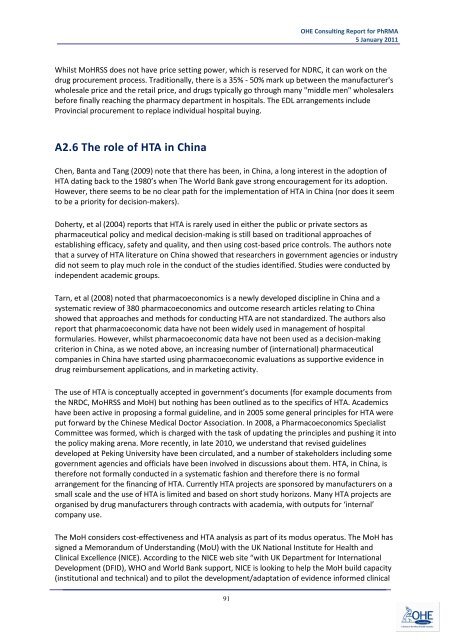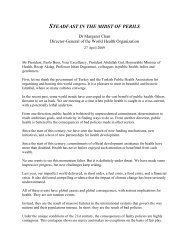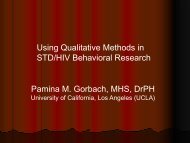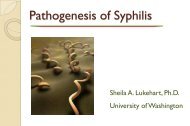The Evolution of HTA in Emerging Markets Health-Care ... - TREE
The Evolution of HTA in Emerging Markets Health-Care ... - TREE
The Evolution of HTA in Emerging Markets Health-Care ... - TREE
Create successful ePaper yourself
Turn your PDF publications into a flip-book with our unique Google optimized e-Paper software.
OHE Consult<strong>in</strong>g Report for PhRMA<br />
5 January 2011<br />
Whilst MoHRSS does not have price sett<strong>in</strong>g power, which is reserved for NDRC, it can work on the<br />
drug procurement process. Traditionally, there is a 35% -‐ 50% mark up between the manufacturer's<br />
wholesale price and the retail price, and drugs typically go through many "middle men" wholesalers<br />
before f<strong>in</strong>ally reach<strong>in</strong>g the pharmacy department <strong>in</strong> hospitals. <strong>The</strong> EDL arrangements <strong>in</strong>clude<br />
Prov<strong>in</strong>cial procurement to replace <strong>in</strong>dividual hospital buy<strong>in</strong>g.<br />
A2.6 <strong>The</strong> role <strong>of</strong> <strong>HTA</strong> <strong>in</strong> Ch<strong>in</strong>a<br />
Chen, Banta and Tang (2009) note that there has been, <strong>in</strong> Ch<strong>in</strong>a, a long <strong>in</strong>terest <strong>in</strong> the adoption <strong>of</strong><br />
<strong>HTA</strong> dat<strong>in</strong>g back to the 1980’s when <strong>The</strong> World Bank gave strong encouragement for its adoption.<br />
However, there seems to be no clear path for the implementation <strong>of</strong> <strong>HTA</strong> <strong>in</strong> Ch<strong>in</strong>a (nor does it seem<br />
to be a priority for decision-‐makers).<br />
Doherty, et al (2004) reports that <strong>HTA</strong> is rarely used <strong>in</strong> either the public or private sectors as<br />
pharmaceutical policy and medical decision-‐mak<strong>in</strong>g is still based on traditional approaches <strong>of</strong><br />
establish<strong>in</strong>g efficacy, safety and quality, and then us<strong>in</strong>g cost-‐based price controls. <strong>The</strong> authors note<br />
that a survey <strong>of</strong> <strong>HTA</strong> literature on Ch<strong>in</strong>a showed that researchers <strong>in</strong> government agencies or <strong>in</strong>dustry<br />
did not seem to play much role <strong>in</strong> the conduct <strong>of</strong> the studies identified. Studies were conducted by<br />
<strong>in</strong>dependent academic groups.<br />
Tarn, et al (2008) noted that pharmacoeconomics is a newly developed discipl<strong>in</strong>e <strong>in</strong> Ch<strong>in</strong>a and a<br />
systematic review <strong>of</strong> 380 pharmacoeconomics and outcome research articles relat<strong>in</strong>g to Ch<strong>in</strong>a<br />
showed that approaches and methods for conduct<strong>in</strong>g <strong>HTA</strong> are not standardized. <strong>The</strong> authors also<br />
report that pharmacoeconomic data have not been widely used <strong>in</strong> management <strong>of</strong> hospital<br />
formularies. However, whilst pharmacoeconomic data have not been used as a decision-‐mak<strong>in</strong>g<br />
criterion <strong>in</strong> Ch<strong>in</strong>a, as we noted above, an <strong>in</strong>creas<strong>in</strong>g number <strong>of</strong> (<strong>in</strong>ternational) pharmaceutical<br />
companies <strong>in</strong> Ch<strong>in</strong>a have started us<strong>in</strong>g pharmacoeconomic evaluations as supportive evidence <strong>in</strong><br />
drug reimbursement applications, and <strong>in</strong> market<strong>in</strong>g activity.<br />
<strong>The</strong> use <strong>of</strong> <strong>HTA</strong> is conceptually accepted <strong>in</strong> government’s documents (for example documents from<br />
the NRDC, MoHRSS and MoH) but noth<strong>in</strong>g has been outl<strong>in</strong>ed as to the specifics <strong>of</strong> <strong>HTA</strong>. Academics<br />
have been active <strong>in</strong> propos<strong>in</strong>g a formal guidel<strong>in</strong>e, and <strong>in</strong> 2005 some general pr<strong>in</strong>ciples for <strong>HTA</strong> were<br />
put forward by the Ch<strong>in</strong>ese Medical Doctor Association. In 2008, a Pharmacoeconomics Specialist<br />
Committee was formed, which is charged with the task <strong>of</strong> updat<strong>in</strong>g the pr<strong>in</strong>ciples and push<strong>in</strong>g it <strong>in</strong>to<br />
the policy mak<strong>in</strong>g arena. More recently, <strong>in</strong> late 2010, we understand that revised guidel<strong>in</strong>es<br />
developed at Pek<strong>in</strong>g University have been circulated, and a number <strong>of</strong> stakeholders <strong>in</strong>clud<strong>in</strong>g some<br />
government agencies and <strong>of</strong>ficials have been <strong>in</strong>volved <strong>in</strong> discussions about them. <strong>HTA</strong>, <strong>in</strong> Ch<strong>in</strong>a, is<br />
therefore not formally conducted <strong>in</strong> a systematic fashion and therefore there is no formal<br />
arrangement for the f<strong>in</strong>anc<strong>in</strong>g <strong>of</strong> <strong>HTA</strong>. Currently <strong>HTA</strong> projects are sponsored by manufacturers on a<br />
small scale and the use <strong>of</strong> <strong>HTA</strong> is limited and based on short study horizons. Many <strong>HTA</strong> projects are<br />
organised by drug manufacturers through contracts with academia, with outputs for ‘<strong>in</strong>ternal’<br />
company use.<br />
<strong>The</strong> MoH considers cost-‐effectiveness and <strong>HTA</strong> analysis as part <strong>of</strong> its modus operatus. <strong>The</strong> MoH has<br />
signed a Memorandum <strong>of</strong> Understand<strong>in</strong>g (MoU) with the UK National Institute for <strong>Health</strong> and<br />
Cl<strong>in</strong>ical Excellence (NICE). Accord<strong>in</strong>g to the NICE web site “with UK Department for International<br />
Development (DFID), WHO and World Bank support, NICE is look<strong>in</strong>g to help the MoH build capacity<br />
(<strong>in</strong>stitutional and technical) and to pilot the development/adaptation <strong>of</strong> evidence <strong>in</strong>formed cl<strong>in</strong>ical<br />
91








